2016 JEEP GRAND CHEROKEE ECO mode
[x] Cancel search: ECO modePage 32 of 723
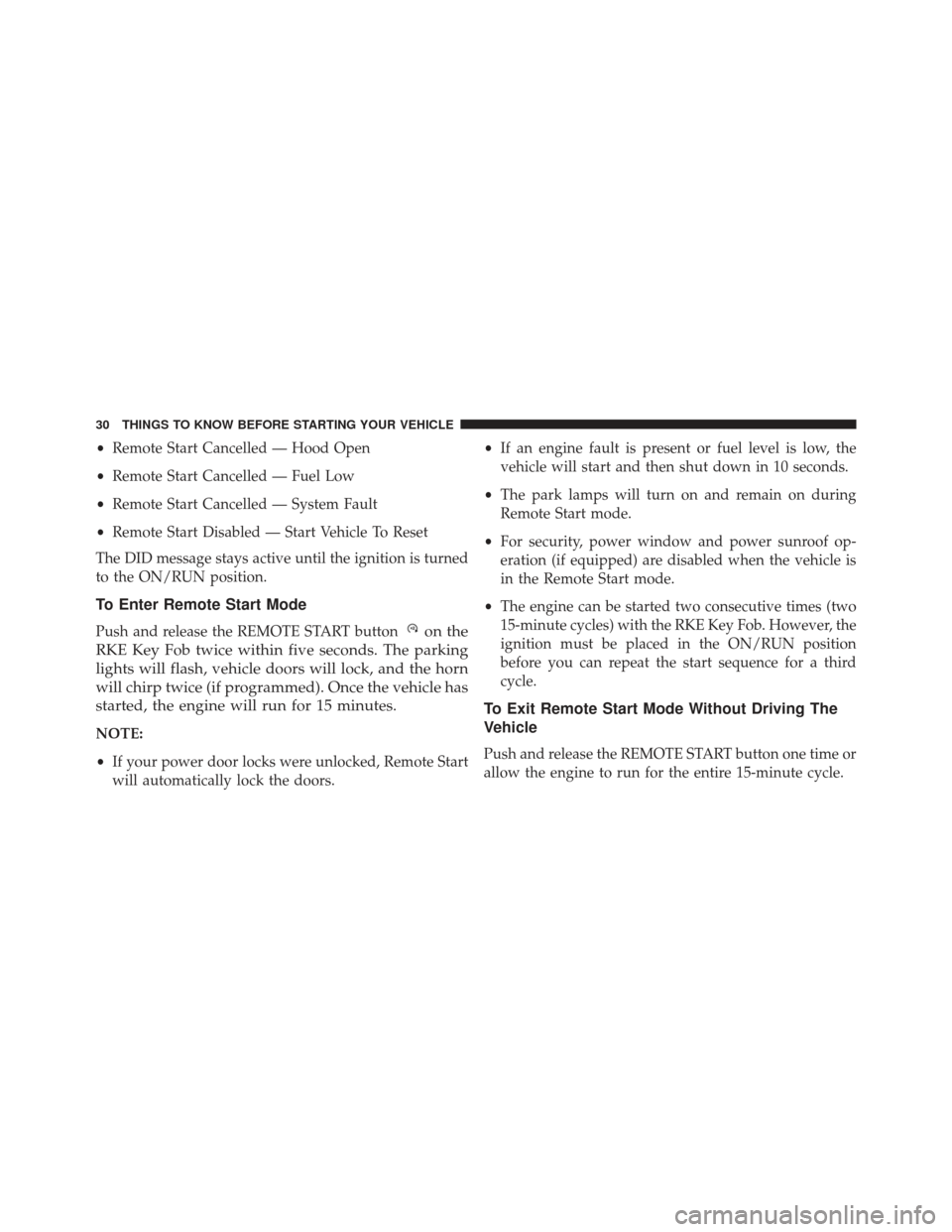
•Remote Start Cancelled — Hood Open
• Remote Start Cancelled — Fuel Low
• Remote Start Cancelled — System Fault
• Remote Start Disabled — Start Vehicle To Reset
The DID message stays active until the ignition is turned
to the ON/RUN position.
To Enter Remote Start Mode
Push and release the REMOTE START buttonon the
RKE Key Fob twice within five seconds. The parking
lights will flash, vehicle doors will lock, and the horn
will chirp twice (if programmed). Once the vehicle has
started, the engine will run for 15 minutes.
NOTE:
• If your power door locks were unlocked, Remote Start
will automatically lock the doors. •
If an engine fault is present or fuel level is low, the
vehicle will start and then shut down in 10 seconds.
• The park lamps will turn on and remain on during
Remote Start mode.
• For security, power window and power sunroof op-
eration (if equipped) are disabled when the vehicle is
in the Remote Start mode.
• The engine can be started two consecutive times (two
15-minute cycles) with the RKE Key Fob. However, the
ignition must be placed in the ON/RUN position
before you can repeat the start sequence for a third
cycle.
To Exit Remote Start Mode Without Driving The
Vehicle
Push and release the REMOTE START button one time or
allow the engine to run for the entire 15-minute cycle.
30 THINGS TO KNOW BEFORE STARTING YOUR VEHICLE
Page 33 of 723
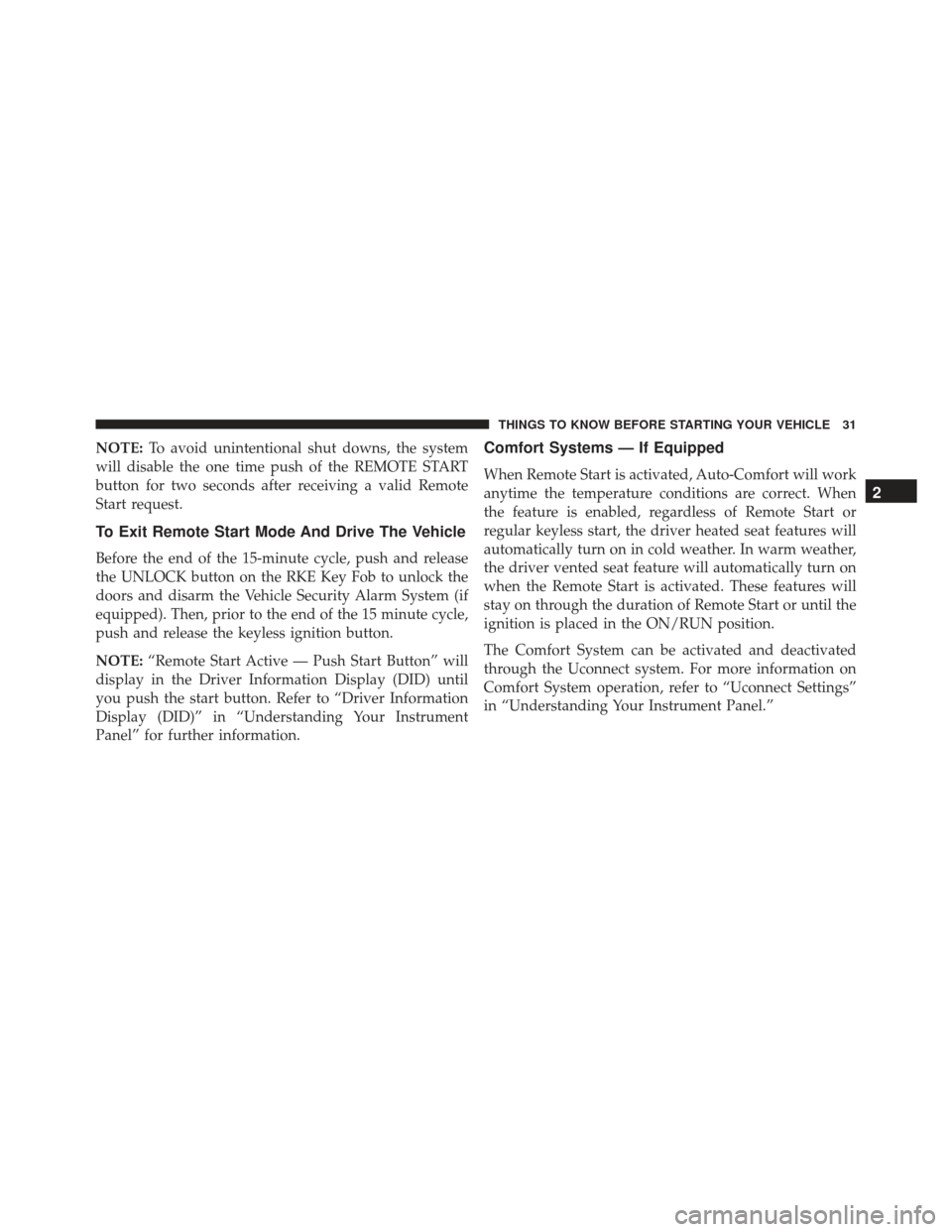
NOTE:To avoid unintentional shut downs, the system
will disable the one time push of the REMOTE START
button for two seconds after receiving a valid Remote
Start request.
To Exit Remote Start Mode And Drive The Vehicle
Before the end of the 15-minute cycle, push and release
the UNLOCK button on the RKE Key Fob to unlock the
doors and disarm the Vehicle Security Alarm System (if
equipped). Then, prior to the end of the 15 minute cycle,
push and release the keyless ignition button.
NOTE: “Remote Start Active — Push Start Button” will
display in the Driver Information Display (DID) until
you push the start button. Refer to “Driver Information
Display (DID)” in “Understanding Your Instrument
Panel” for further information.
Comfort Systems — If Equipped
When Remote Start is activated, Auto-Comfort will work
anytime the temperature conditions are correct. When
the feature is enabled, regardless of Remote Start or
regular keyless start, the driver heated seat features will
automatically turn on in cold weather. In warm weather,
the driver vented seat feature will automatically turn on
when the Remote Start is activated. These features will
stay on through the duration of Remote Start or until the
ignition is placed in the ON/RUN position.
The Comfort System can be activated and deactivated
through the Uconnect system. For more information on
Comfort System operation, refer to “Uconnect Settings”
in “Understanding Your Instrument Panel.”
2
THINGS TO KNOW BEFORE STARTING YOUR VEHICLE 31
Page 46 of 723
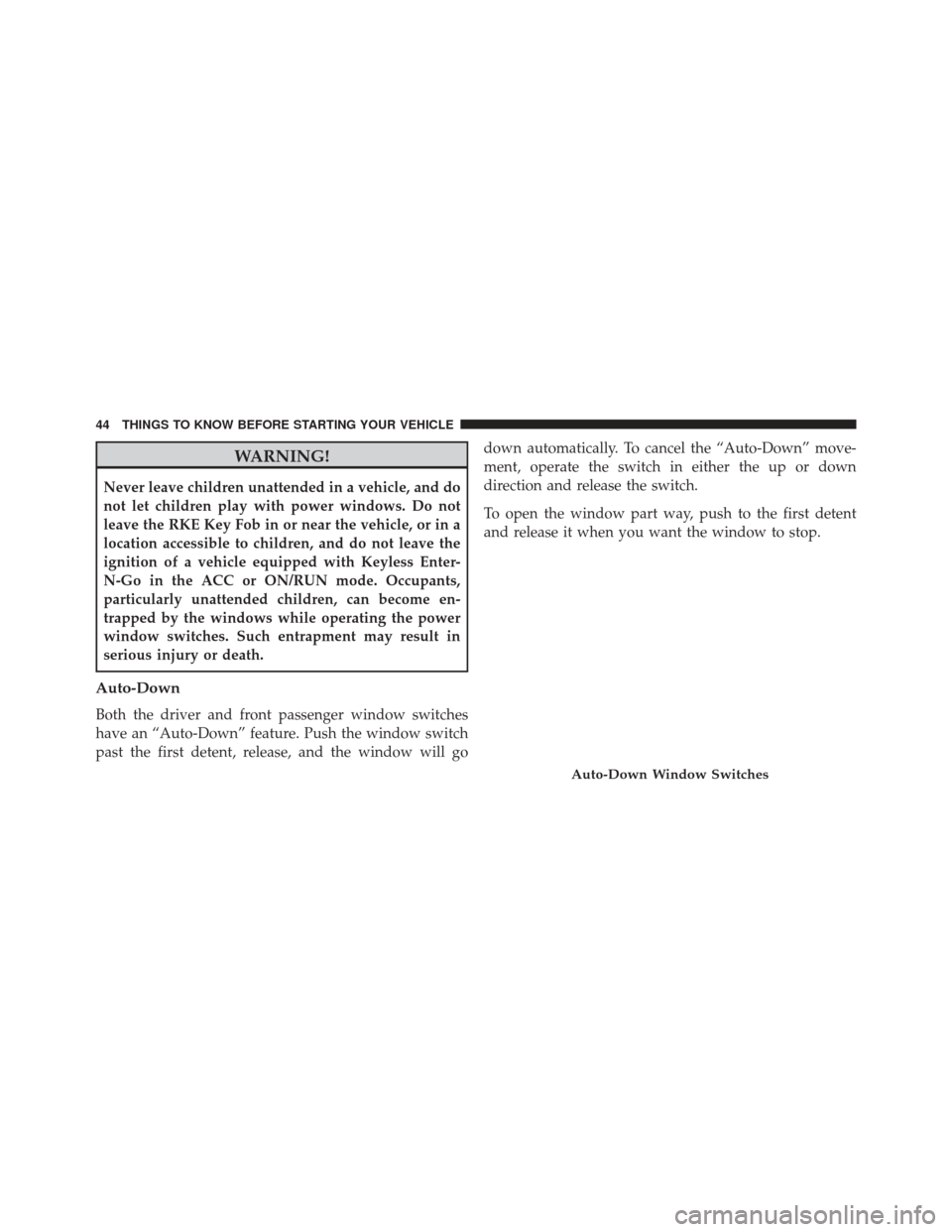
WARNING!
Never leave children unattended in a vehicle, and do
not let children play with power windows. Do not
leave the RKE Key Fob in or near the vehicle, or in a
location accessible to children, and do not leave the
ignition of a vehicle equipped with Keyless Enter-
N-Go in the ACC or ON/RUN mode. Occupants,
particularly unattended children, can become en-
trapped by the windows while operating the power
window switches. Such entrapment may result in
serious injury or death.
Auto-Down
Both the driver and front passenger window switches
have an “Auto-Down” feature. Push the window switch
past the first detent, release, and the window will godown automatically. To cancel the “Auto-Down” move-
ment, operate the switch in either the up or down
direction and release the switch.
To open the window part way, push to the first detent
and release it when you want the window to stop.
Auto-Down Window Switches
44 THINGS TO KNOW BEFORE STARTING YOUR VEHICLE
Page 104 of 723
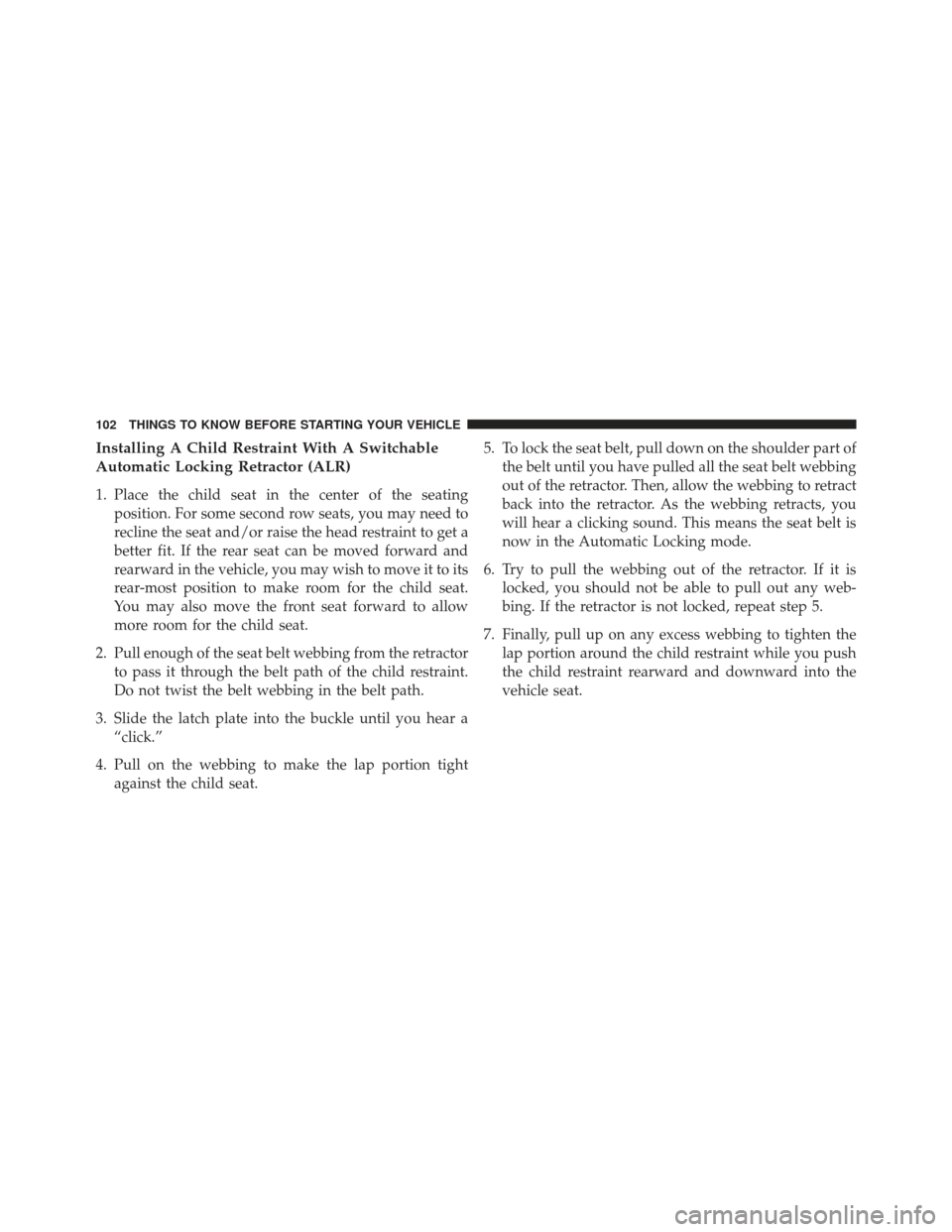
Installing A Child Restraint With A Switchable
Automatic Locking Retractor (ALR)
1. Place the child seat in the center of the seatingposition. For some second row seats, you may need to
recline the seat and/or raise the head restraint to get a
better fit. If the rear seat can be moved forward and
rearward in the vehicle, you may wish to move it to its
rear-most position to make room for the child seat.
You may also move the front seat forward to allow
more room for the child seat.
2. Pull enough of the seat belt webbing from the retractor to pass it through the belt path of the child restraint.
Do not twist the belt webbing in the belt path.
3. Slide the latch plate into the buckle until you hear a “click.”
4. Pull on the webbing to make the lap portion tight against the child seat. 5. To lock the seat belt, pull down on the shoulder part of
the belt until you have pulled all the seat belt webbing
out of the retractor. Then, allow the webbing to retract
back into the retractor. As the webbing retracts, you
will hear a clicking sound. This means the seat belt is
now in the Automatic Locking mode.
6. Try to pull the webbing out of the retractor. If it is locked, you should not be able to pull out any web-
bing. If the retractor is not locked, repeat step 5.
7. Finally, pull up on any excess webbing to tighten the lap portion around the child restraint while you push
the child restraint rearward and downward into the
vehicle seat.
102 THINGS TO KNOW BEFORE STARTING YOUR VEHICLE
Page 109 of 723
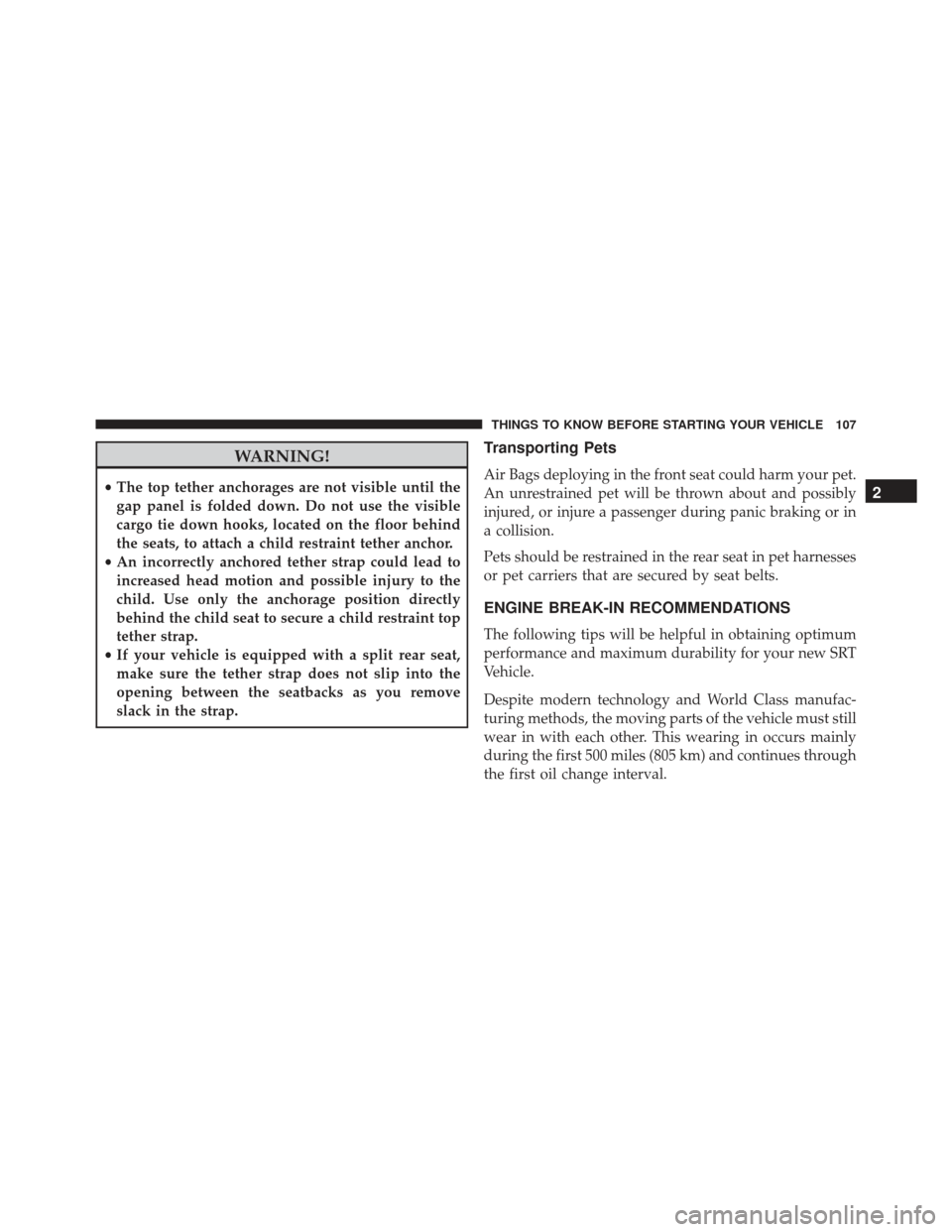
WARNING!
•The top tether anchorages are not visible until the
gap panel is folded down. Do not use the visible
cargo tie down hooks, located on the floor behind
the seats, to attach a child restraint tether anchor.
• An incorrectly anchored tether strap could lead to
increased head motion and possible injury to the
child. Use only the anchorage position directly
behind the child seat to secure a child restraint top
tether strap.
• If your vehicle is equipped with a split rear seat,
make sure the tether strap does not slip into the
opening between the seatbacks as you remove
slack in the strap.
Transporting Pets
Air Bags deploying in the front seat could harm your pet.
An unrestrained pet will be thrown about and possibly
injured, or injure a passenger during panic braking or in
a collision.
Pets should be restrained in the rear seat in pet harnesses
or pet carriers that are secured by seat belts.
ENGINE BREAK-IN RECOMMENDATIONS
The following tips will be helpful in obtaining optimum
performance and maximum durability for your new SRT
Vehicle.
Despite modern technology and World Class manufac-
turing methods, the moving parts of the vehicle must still
wear in with each other. This wearing in occurs mainly
during the first 500 miles (805 km) and continues through
the first oil change interval.
2
THINGS TO KNOW BEFORE STARTING YOUR VEHICLE 107
Page 113 of 723
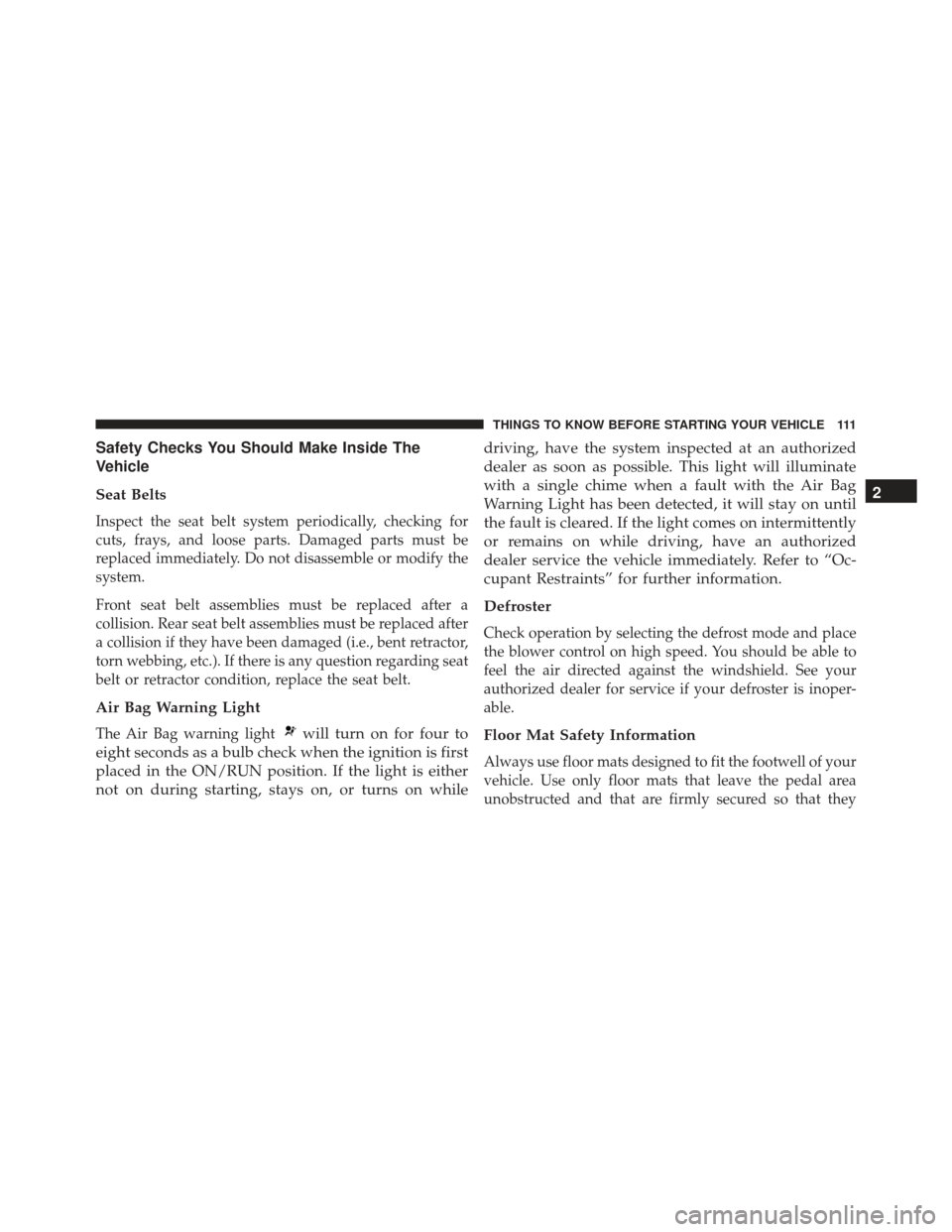
Safety Checks You Should Make Inside The
Vehicle
Seat Belts
Inspect the seat belt system periodically, checking for
cuts, frays, and loose parts. Damaged parts must be
replaced immediately. Do not disassemble or modify the
system.
Front seat belt assemblies must be replaced after a
collision. Rear seat belt assemblies must be replaced after
a collision if they have been damaged (i.e., bent retractor,
torn webbing, etc.). If there is any question regarding seat
belt or retractor condition, replace the seat belt.
Air Bag Warning Light
The Air Bag warning lightwill turn on for four to
eight seconds as a bulb check when the ignition is first
placed in the ON/RUN position. If the light is either
not on during starting, stays on, or turns on while driving, have the system inspected at an authorized
dealer as soon as possible. This light will illuminate
with a single chime when a fault with the Air Bag
Warning Light has been detected, it will stay on until
the fault is cleared. If the light comes on intermittently
or remains on while driving, have an authorized
dealer service the vehicle immediately. Refer to “Oc-
cupant Restraints” for further information.
Defroster
Check operation by selecting the defrost mode and place
the blower control on high speed. You should be able to
feel the air directed against the windshield. See your
authorized dealer for service if your defroster is inoper-
able.
Floor Mat Safety Information
Always use floor mats designed to fit the footwell of your
vehicle. Use only floor mats that leave the pedal area
unobstructed and that are firmly secured so that they
2
THINGS TO KNOW BEFORE STARTING YOUR VEHICLE 111
Page 130 of 723
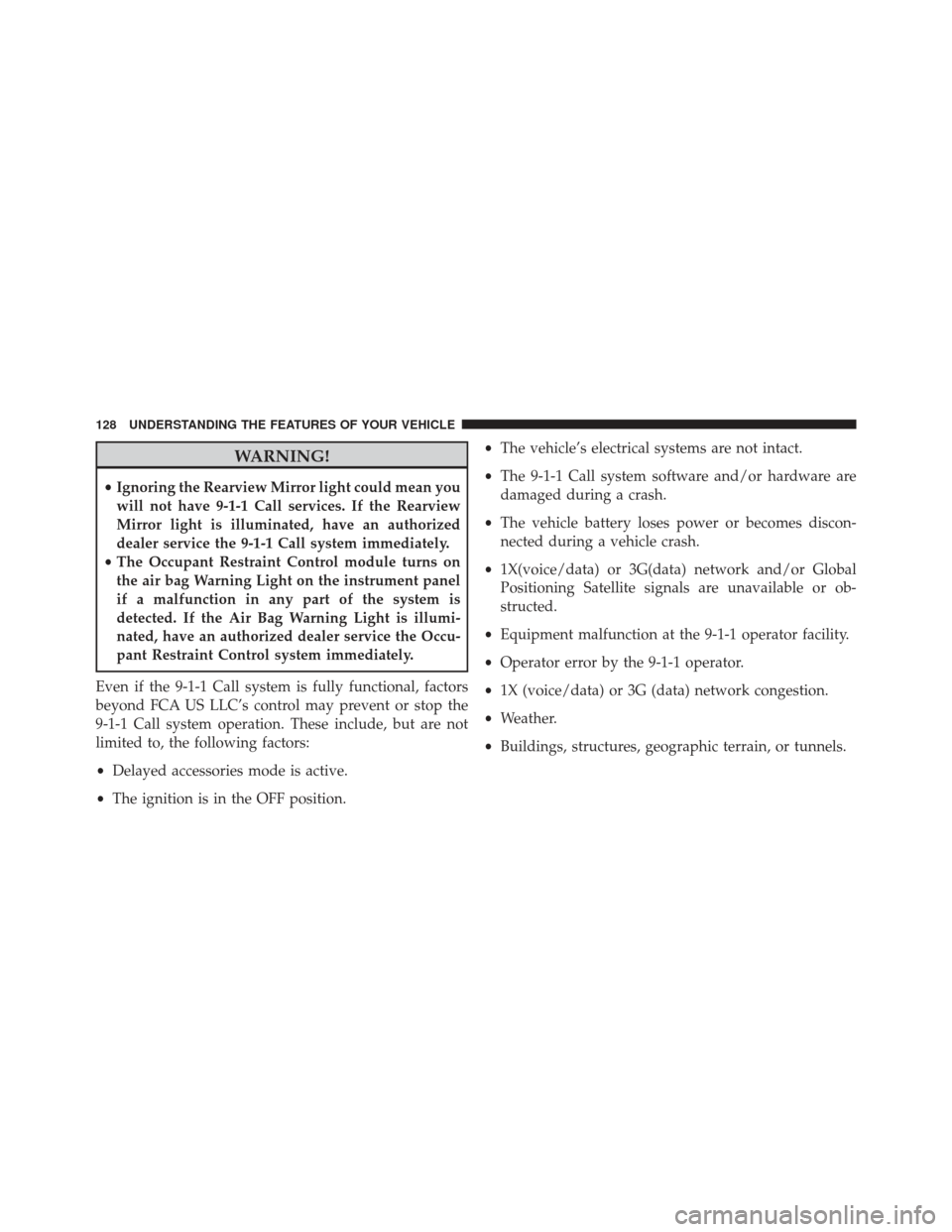
WARNING!
•Ignoring the Rearview Mirror light could mean you
will not have 9-1-1 Call services. If the Rearview
Mirror light is illuminated, have an authorized
dealer service the 9-1-1 Call system immediately.
• The Occupant Restraint Control module turns on
the air bag Warning Light on the instrument panel
if a malfunction in any part of the system is
detected. If the Air Bag Warning Light is illumi-
nated, have an authorized dealer service the Occu-
pant Restraint Control system immediately.
Even if the 9-1-1 Call system is fully functional, factors
beyond FCA US LLC’s control may prevent or stop the
9-1-1 Call system operation. These include, but are not
limited to, the following factors:
• Delayed accessories mode is active.
• The ignition is in the OFF position. •
The vehicle’s electrical systems are not intact.
• The 9-1-1 Call system software and/or hardware are
damaged during a crash.
• The vehicle battery loses power or becomes discon-
nected during a vehicle crash.
• 1X(voice/data) or 3G(data) network and/or Global
Positioning Satellite signals are unavailable or ob-
structed.
• Equipment malfunction at the 9-1-1 operator facility.
• Operator error by the 9-1-1 operator.
• 1X (voice/data) or 3G (data) network congestion.
• Weather.
• Buildings, structures, geographic terrain, or tunnels.
128 UNDERSTANDING THE FEATURES OF YOUR VEHICLE
Page 152 of 723
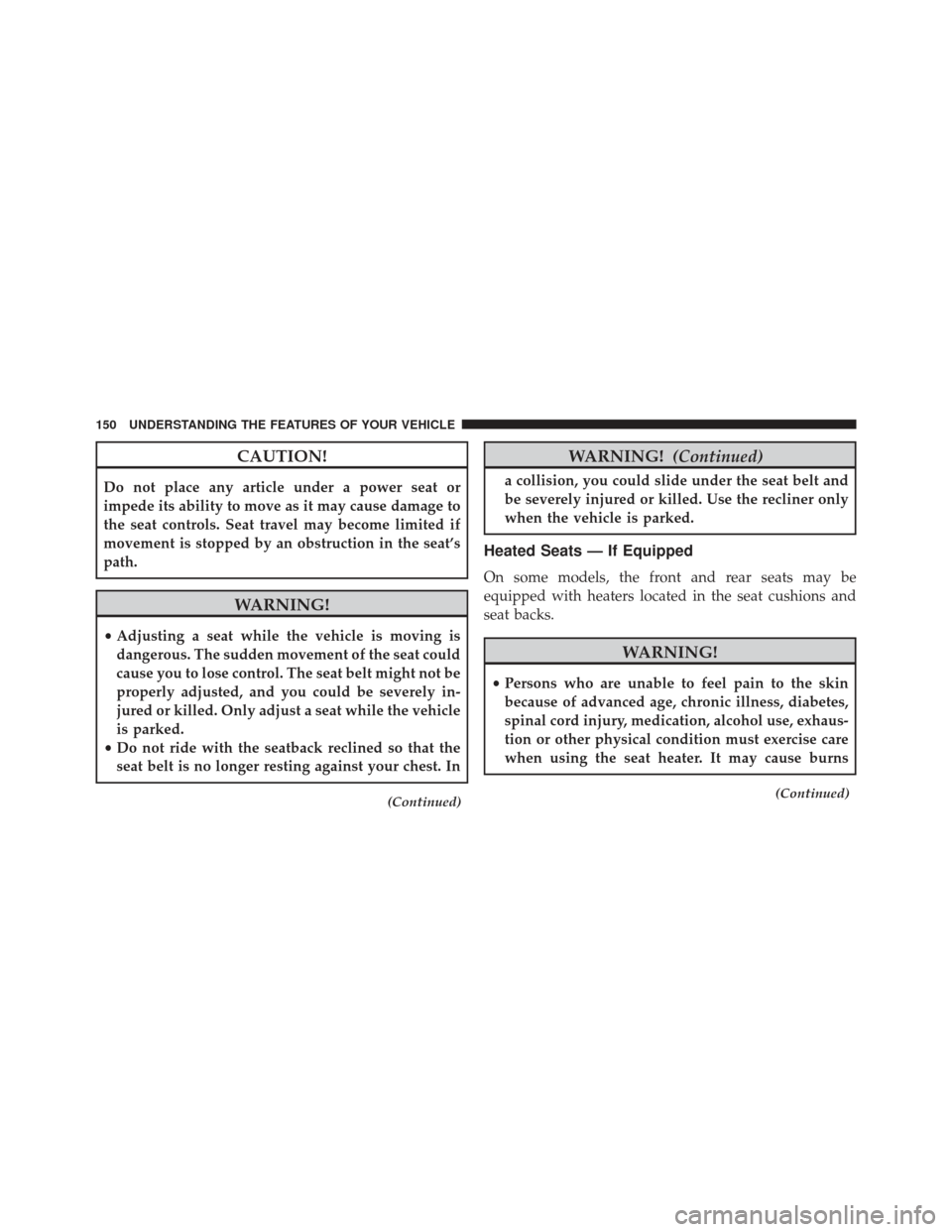
CAUTION!
Do not place any article under a power seat or
impede its ability to move as it may cause damage to
the seat controls. Seat travel may become limited if
movement is stopped by an obstruction in the seat’s
path.
WARNING!
•Adjusting a seat while the vehicle is moving is
dangerous. The sudden movement of the seat could
cause you to lose control. The seat belt might not be
properly adjusted, and you could be severely in-
jured or killed. Only adjust a seat while the vehicle
is parked.
• Do not ride with the seatback reclined so that the
seat belt is no longer resting against your chest. In
(Continued)
WARNING! (Continued)
a collision, you could slide under the seat belt and
be severely injured or killed. Use the recliner only
when the vehicle is parked.
Heated Seats — If Equipped
On some models, the front and rear seats may be
equipped with heaters located in the seat cushions and
seat backs.
WARNING!
•Persons who are unable to feel pain to the skin
because of advanced age, chronic illness, diabetes,
spinal cord injury, medication, alcohol use, exhaus-
tion or other physical condition must exercise care
when using the seat heater. It may cause burns
(Continued)
150 UNDERSTANDING THE FEATURES OF YOUR VEHICLE